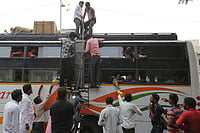Indian media is dominated by upper castes, and media organisations have failed to diversify their newsroom and news coverage, reveals a new report released by Oxfam India and Newslaundry.
The report ‘Who Tells Our Stories Matters: Representation of marginalised caste groups in Indian Newsrooms’ studies the representation of people from different caste groups in the Indian media.
“The report starkly reaffirms that marginalised groups are absent in news media, particularly in leadership positions which determine who gets the space. Even stories written on those affected by discrimination are by those who are privileged and upper caste. Honest collective efforts have not been made to include more voices and create equal representation in newsrooms. It is disheartening to see that media, which is one of most recognised institution of democracy, fails Dalits, Adivasis and other marginalised groups.”
“This report is important for those working in and working with the media as it presents an opportunity before them to deliberate a way forward that upholds the constitutional guarantees of equality and fraternity,” said Amitabh Behar, Chief Executive Officer, Oxfam India.
The report uses multiple methods — surveys, byline count and triangulation with publicly available government sources to identify castes of journalists, anchors, writers, editors and panellists. Six English and seven Hindi newspapers, flagship debate shows on 14 television channels, 11 digital news outlets, and 12 magazines were examined to collect caste details for the period of October 2018 to Match 2019. Over 65,000 articles and news debates were analysed across the publications to provide a quantitative picture of which groups get to speak on various subjects and to what extent.
‘Who Tells Our Stories Matters: Representation of marginalised caste groups in Indian Newsrooms’ was launched as journalists from across the country gathered at the Media Rumble in New Delhi. Some of the key findings of the report are:
Of the 121 newsroom leadership positions – editor-in-chief, managing editor, executive editor, bureau chief, input/output editor – across the newspapers, TV news channels, news websites, and magazines under study, 106 are occupied by upper castes, five by other backward classes and six by people from minority communities. The case of four individuals could not be identified.
Three out of every four anchors (among a total of 40 anchors in Hindi channels and 47 in English channels) of debates are upper caste. Not one is Dalit, Adivasi, or OBC.
For over 70% of their primetime debate shows, news channels draw the majority of the panellists from the upper castes
The report suggests urgent need to take proactive steps, including affirmative action, to diversify newsrooms in line with the country’s social and demographic character. To this end, systems to encourage inclusion must be put in place, and concerted efforts made to train and hire journalists from across the social spectrum.


























